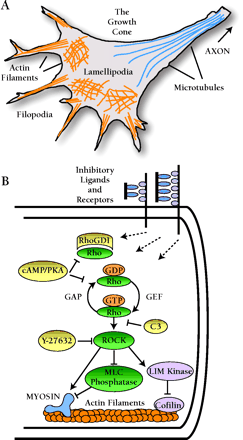
- Institution: Stanford Univ Med Ctr Lane Med Lib/Periodical Dept/Rm L109
- Sign In as Member / Individual
Molecular Targets for Therapeutic Intervention after Spinal Cord Injury

The growth cone: Features and inhibitory signaling pathways. A. A growth cone has distinct actin filament-based features, including distal, finger-like filopodia and central, fan-shaped lamellipodia. B. Schematic diagram of the Rho-signaling pathway in the growth cone, a possible pathway of convergence for numerous extracellular stimuli. Receptor activation somehow alters the balance of Rho-GEF and Rho-GAP activity so as to favor an increase in activated, GTP-bound Rho. Conversely, Rho activity can be down-regulated by RhoGDI sequestration to the cytoplasm, an effect promoted by intracellular cAMP/PKA elevation. Rho-GTP activates its downstream effector kinases, of which ROCK is depicted here. ROCK in turn has effects on several substrates that affect actin events that lead to growth cone advance or retraction. (GAP, GTPase activating proteins; GEF, guanosine nucleotide exchange factors; RhoGDI, Rho guanosine nucleotide dissociation inhibitor; ROCK, Rho-kinase; PKA, protein kinase A.)


